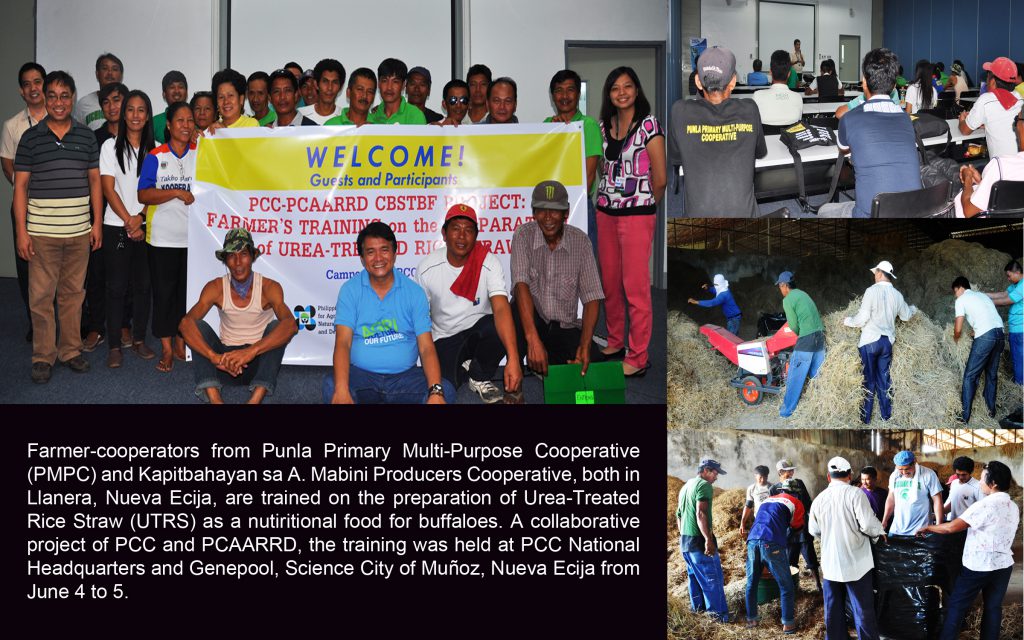Farmer-cooperators can now have a possible means of getting additional income and improved milk production performance among their buffaloes thru the preparation of Urea-Treated Rice Straw (UTRS).
A training on the topic was held on June 4-5 at the Philippine Carabao Center (PCC), National Headquarters and Genepool, Science City of Muñoz, Nueva Ecija as part of a collaborative project of PCC and Philippine Council for Agriculture, Aquatic and Natural Resources Research and Development (PCAARRD). It involved lectures and actual UTRS preparation as well as the proper ensiling with the use of plastic bags.
Dr. Eric P. Palacpac, Dr. Daniel L. Aquino, Mr. Honorato Baltazar, all from PCC and Mr. Napoleon M. Liloc, VP Operations, Macondray Plastics served as resource speakers and facilitators in the training.
The training was participated in by 22 farmer-cooperators from LLanera, Nueva Ecija, 12 of which were from Punla Primary Multi-Purpose Cooperative (PMPC), Bosque Llanera, while 10 were from Kapitbahayan sa A. Mabini Producers Cooperative, Mabini, also in Llanera.
According to Dr. Daniel L. Aquino, project leader and Animal Nutrition Head, the purpose of the training was for the farmers to engage in, adopt and utilize UTRS to improve the milk production performance of their buffaloes.
“Ituturo sa kanila ang tamang paggamit at pagbuburo (UTRS), then later on makikita natin yung epekto sa milk production. Dagdag income din ito sa farmers, ‘pag natuto silang gumawa, isang opportunity yun para magkaro’n sila ng business (We will teach them the proper use and ensiling of UTRS, eventually we will see its effect on the milk yield. It is also an additional income for farmer-cooperators; if they learn how to make silage, then that would be another business opportunity for them),” Dr. Aquino said.
Rice straw alone is a poor quality roughage, as it has low crude protein and low digestibility, thus alkali treatment using urea is encouraged.
Rice straws are treated with urea solution, to improve its crude protein, digestibility and voluntary intake by buffaloes resulting in increased milk production performance, and income of dairy buffalo farmers.
“There are tons of rice straw in Nueva Ecija and it is not good and wise particularly to the environment to just burn them. There are other beneficial uses of rice straws, such as mulching materials, culture media for mushroom production, and more importantly as feedstuff for ruminants,” Dr. Eric P. Palacpac, R&D coordinator, said from his presentation.
Among other topics covered were production and utilization of UTRS, plastic bags for ensiling and economics of UTRS.
During the actual preparation on UTRS, farmers from both cooperatives were tasked to perform the proper ensiling of UTRS (1,000 kg) using plastic bags. Applying the accurate amount of urea, molasses and water was also done.
“Yung UTRS, pang supplement sa pagkain ng mga kalabaw, para hindi mamayat. Dapat maibigay mo yung pangangailangan ng kalabaw mo at yung sustansiya ng pagkain niya para makapagbigay siya ng magandang gatas, give and take process dapat. Pwede pa naming pagkakitaan ang pagbuburo dahil mabebenta namin ng dalawang piso kada isang kilo ang magagawa namin, (UTRS is actually a food supplement among buffaloes to keep them healthy. It should be a give-and-take process. As you require a good quality of milk from your buffalo, in return, you have to ensure that they also receive proper care and nutrition),” Epitacio Arcega, Barangay Captain of Mabini LLanera, said.
UTRS has to be ensiled for three weeks to one month before opening so as to let the steam or gas drop-off. One thousand kilogram (1,000 kg) of ensiled UTRS can be fed to a single buffalo for one month.
“Marami akong natutunan, unang-una ang tamang paggamit ng UTRS, dati kasi ang pinapakain lang namin ay puro ginikan at damo, nagkukulang sa sustansiya yung kalabaw, kaya para mas maging masustansiya yung kinakain nila, itinuro samin yung UTRS at pagbuburo. (I learned a lot, first is the proper use of UTRS. We used to feed our buffaloes with weeds as forage thus they lack nutrients. So to improve the nutritive value of feedstuff, we were introduced to the use of UTRS and silage),” Herminia Mallari, Chairman of Kapitbahayan Cooperative, said.

